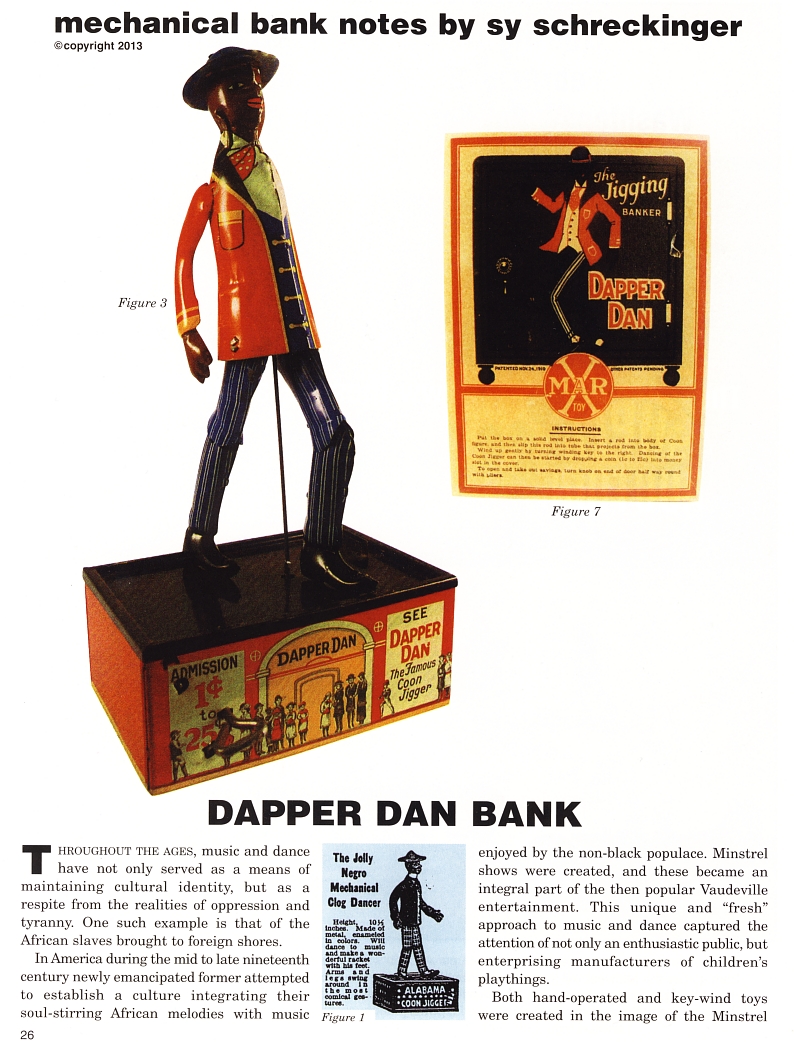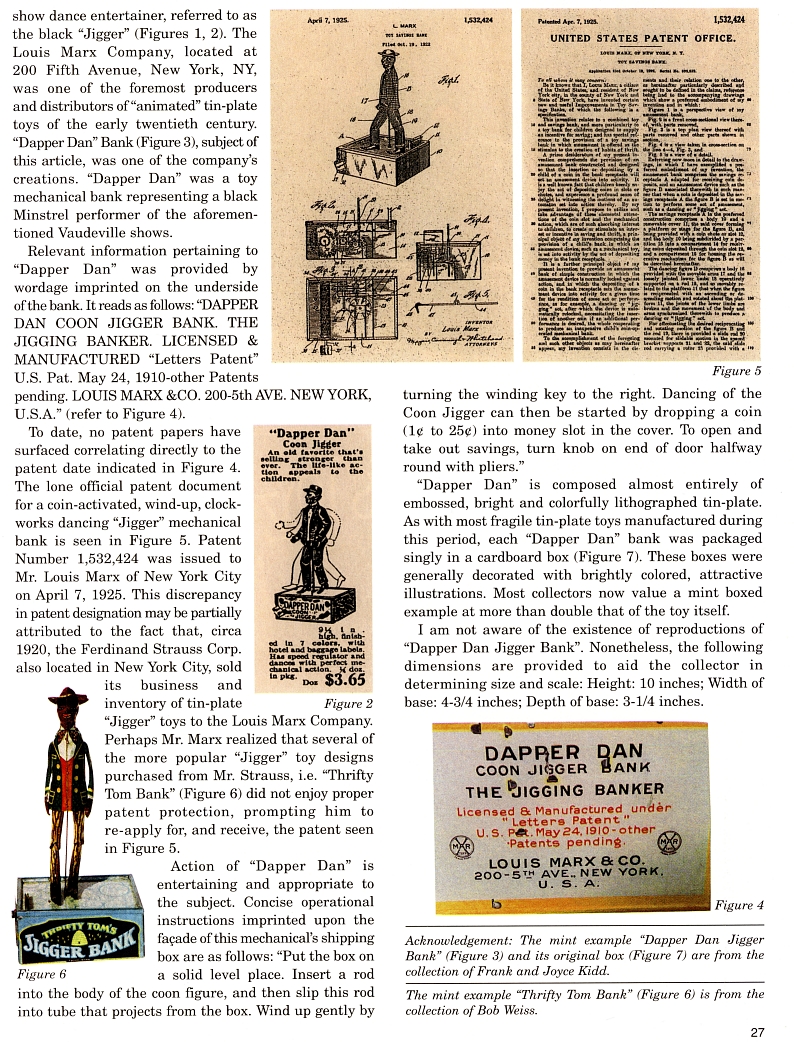|
DAPPER DAN BANK
by Sy Schreckinger – ANTIQUE TOY WORLD Magazine –
February, 2013
THROUGHOUT THE AGES, music and dance have not only served as a means of
maintaining cultural identity, but as a respite from the realities of
oppression and tyranny. One such example is that of the African slaves
brought to foreign shores.
In America during the mid to late nineteenth century newly
emancipated former attempted to establish a culture integrating their
soul-stirring African melodies with music enjoyed by the non-black
populace. Minstrel shows were created, and these became an integral part
of the then popular Vaudeville entertainment. This unique and "fresh"
approach to music and dance captured the attention of not only an
enthusiastic public, but enterprising manufacturers of children's
playthings.
Both hand-operated and key-wind toys were created in the image of the
Minstrel show dance entertainer, referred to as the black "Jigger"
(Figures 1, 2). The Louis Marx Company, located at 200 Fifth Avenue, New
York, NY, was one of the foremost producers and distributors of
"animated" tin-plate toys of the early twentieth century. "Dapper Dan"
Bank (Figure :3), subject of this article, was one of the company's
creations. "Dapper Dan" was a toy mechanical bank representing a black
Minstrel performer of the aforementioned Vaudeville shows.
Relevant information pertaining to "Dapper Dan" was provided by
wordage imprinted on the underside of the bank. It reads as follows:
"DAPPER DAN COON JIGGER BANK. THE JIGGING BANKER. LICENSED &
MANUFACTURED "Letters Patent" U.S. Pat. May 24, 1910-other Patents
pending. LOUIS MARX &CO. 200-5th AVE. NEW YORK, U.S.A." (refer to Figure
4).
To date, no patent papers have surfaced correlating directly to the
patent date indicated in Figure 4. The lone official patent document for
a coin-activated, wind-up, clockworks dancing "Jigger" mechanical bank
is seen in Figure 5. Patent Number 1,532,424 was issued to Mr. Louis
Marx of New York City on April 7, 1925. This discrepancy in patent
designation may be partially attributed to the fact that, circa 1920,
the Ferdinand Strauss Corp. also located in New York City, sold its
business and inventory of tin-plate Figure 2 "Jigger" toys to the Louis
Marx Company. Perhaps Mr. Marx realized that several of the more popular
"Jigger" toy designs purchased from Mr. Strauss, i.e. "Thrifty Tom Bank"
(Figure (5) did not enjoy proper patent protection, prompting him to
re-apply for, and receive, the patent seen in Figure 5.
Action of "Dapper Dan" is entertaining and appropriate to the
subject. Concise operational instructions imprinted upon the facade of
this mechanical's shipping box are as follows: "Put the box on Figure 6
a solid level place. Insert a rod into the body of the coon figure, and
then slip this rod into tube that projects from the box. Wind up gently
by turning the winding key to the right. Dancing of the Coon Jigger can
then be started by dropping a coin (1st to 250) into money slot in the
cover. To open and take out savings, turn knob on end of door halfway
round with pliers."
"Dapper Dan" is composed almost entirely of embossed, bright and
colorfully lithographed tin-plate. As with most fragile tin-plate toys
manufactured during this period, each "Dapper Dan" bank was packaged
singly in a cardboard box (Figure 7). These boxes were generally
decorated with brightly colored, attractive illustrations. Most
collectors now value a mint boxed example at more than double that of
the toy itself.
I am not aware of the existence of reproductions of "Dapper Dan
Jigger Bank". Nonetheless, the following dimensions are provided to aid
the collector in determining size and scale: Height: 10 inches; Width of
base: 4-3/4 inches; Depth of base: 3-1/4 inches.
Acknowledgement: The mint example "Dapper Dan Jigger Bank"
'Figure .7) and its original box
(Figure 7) are from the collection of
Frank and Joyce Kidd.
The mint example "Thrifty Tom Bank" (Figure 6) is front the
collection of Bob Weiss. |


